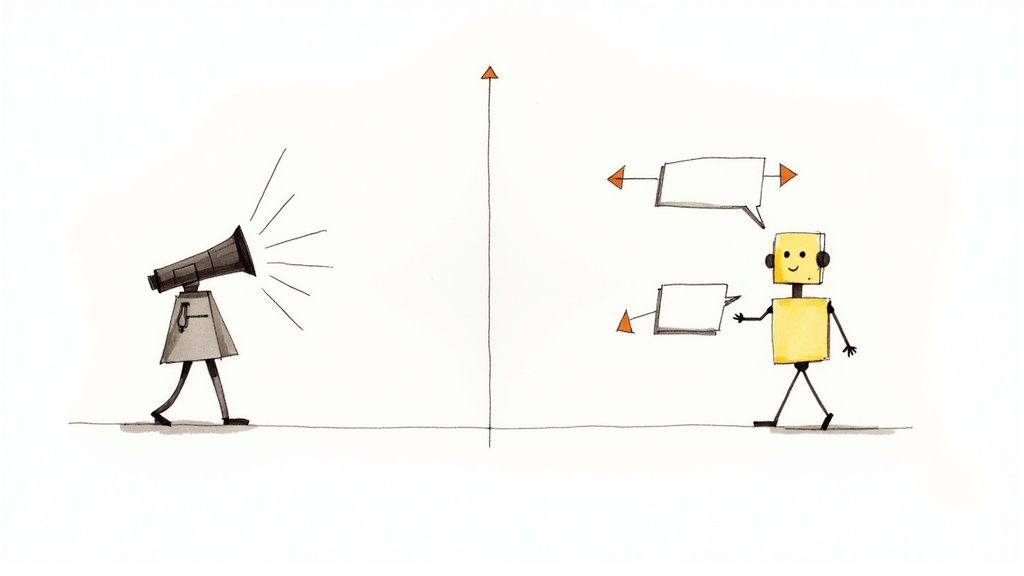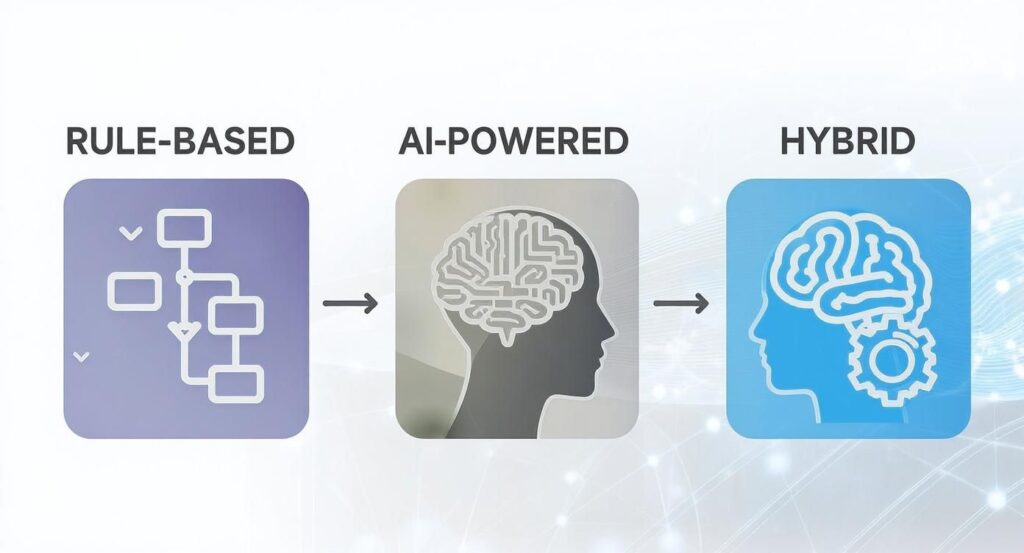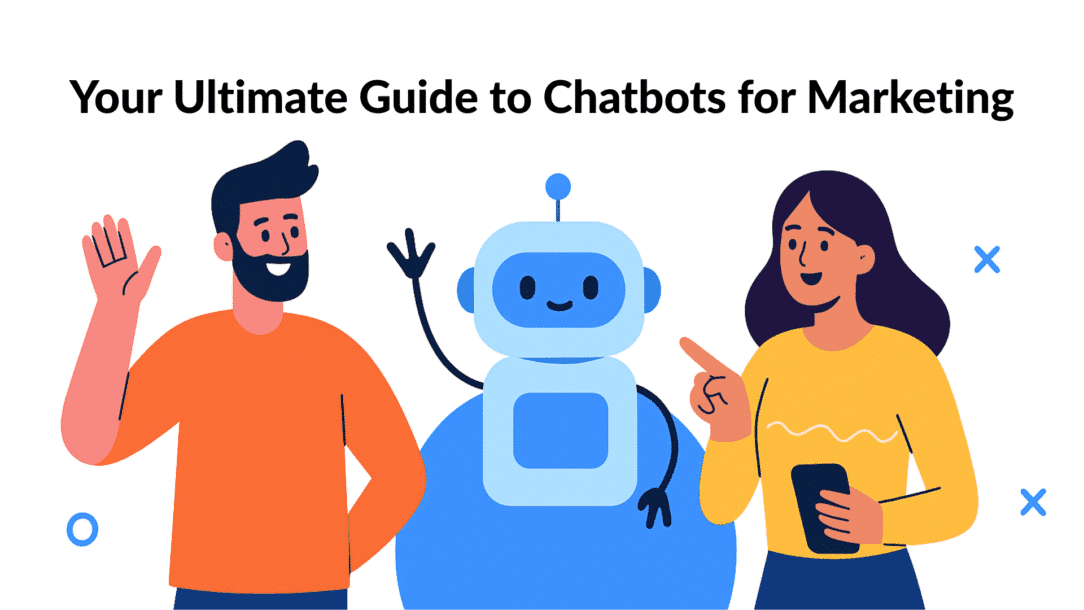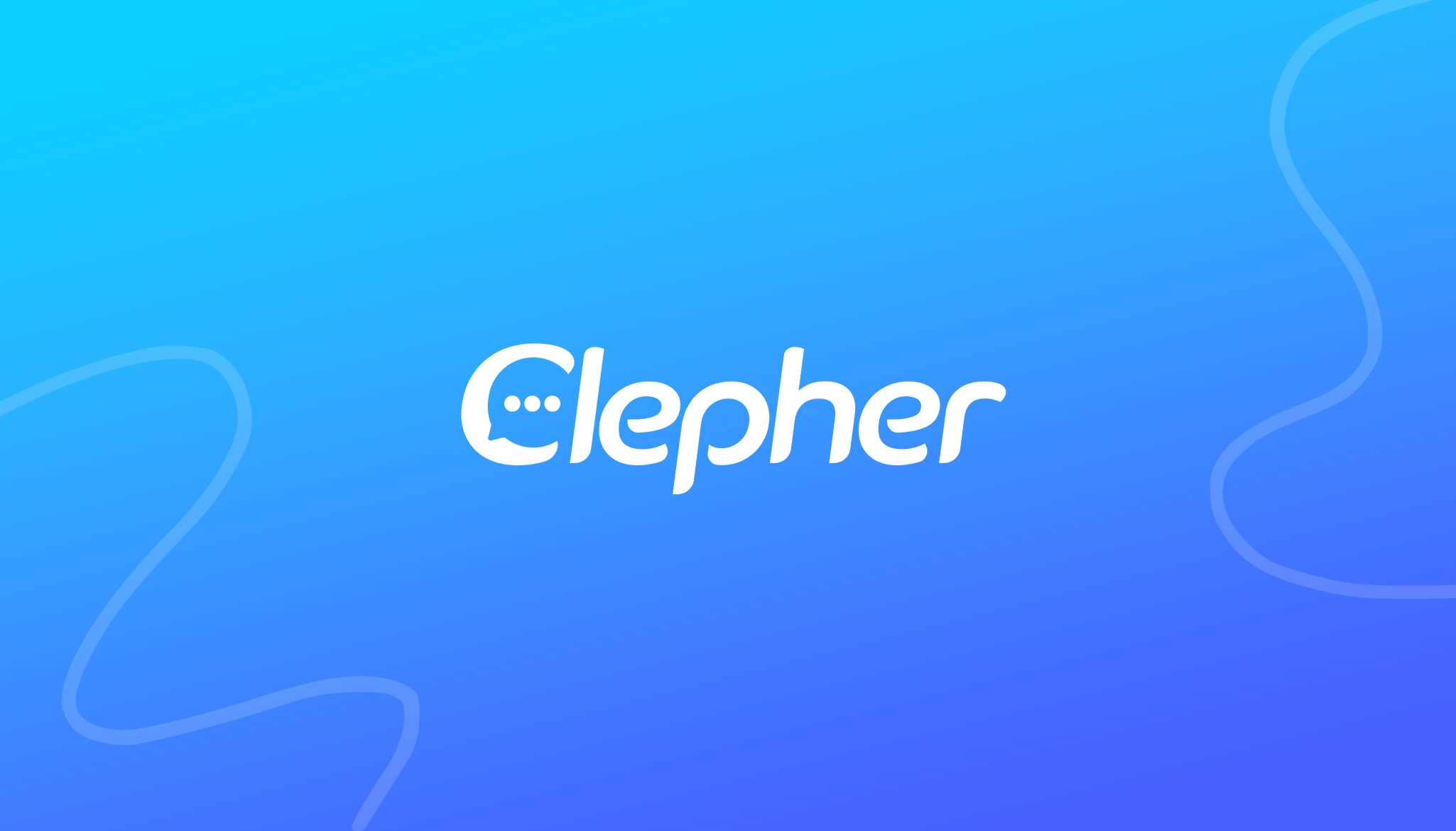Chatbots for marketing are no longer just glorified FAQ machines. They are your secret weapon for turning passive website visitors and social media scrollers into actively engaged customers. Think of them as your always-on, 24/7 marketing team, ready to generate leads, qualify prospects, and drive sales even while you sleep.
Why Chatbots Are a Game-Changer for Marketing

chatbots as marketing game changer
Think about traditional marketing like a mass email blast. It’s a monologue. You broadcast a message and hope something sticks. It’s a one-way street with no room for a real-time conversation.
Now, imagine a helpful, two-way dialogue kicking off the moment someone shows interest. That’s the power of a chatbot. It transforms your marketing from a broadcast into a personal conversation, meeting customers where they are—on your website, in Facebook Messenger, or on Instagram—to provide instant, valuable answers.
This is the core of what is conversational marketing, a strategy focused on building relationships through real-time dialogue.
From Support Tool to Sales Engine
For years, chatbots were viewed as simple customer support tools — great for answering FAQs and easing the workload for service teams. While that’s still one of their strengths, their role has evolved far beyond basic support.
Today, AI chatbots for marketing have become powerful engines for lead generation, sales, and customer engagement. They no longer sit idle, waiting for a customer to reach out. Instead, they proactively start conversations, nurture relationships, and drive revenue.
So what’s driving this shift? Modern customers expect instant, personalized, and frictionless interactions throughout their buying journey — and chatbots make that possible. This evolution highlights one of the biggest benefits of chatbot marketing: automation that feels genuinely human and helpful.
Lead Nurturing: Chatbots can ask smart, qualifying questions, identify high-intent prospects, and deliver the right content to move them further down the funnel. For instance, it might ask, “What’s your biggest marketing challenge right now?” and then share a relevant case study or resource instantly.
Sales Enablement: Acting as a personal shopper, a chatbot can recommend products based on user preferences, offer tailored discounts, and even guide customers through checkout directly within the chat — reducing drop-offs and boosting conversions.
Brand Experience: When designed with a bit of personality, a chatbot becomes more than just a tool — it becomes part of the brand experience. It creates memorable, on-brand interactions that build trust and keep customers coming back for more.
The Numbers Don’t Lie
This shift isn’t just a trend; it’s a massive market transformation backed by data. The global chatbot market is projected to skyrocket, showing how seriously businesses are taking personalized, instant customer engagement. You can find detailed stats in recent industry reports on MordorIntelligence.com.
This growth is fueled by the fact that messaging apps are now a primary way people connect with brands, creating a win-win for building brand awareness and delighting customers.
A well-designed chatbot does more than answer questions. It creates an experience, guiding users from curiosity to conversion with a seamless, conversational flow that feels both personal and efficient.
Putting Chatbots to Work: Real-World Marketing Use Cases

chatbot marketing
Theory is great, but let’s talk results. Marketing chatbots are practical tools that solve everyday marketing challenges by engaging audiences, capturing leads, and driving sales automatically.
By automating those critical first interactions, you create a responsive and personal journey for every person who lands on your site. Let’s dig into specific, actionable ways a chatbot can start working for your business today.
Marketing Chatbot Use Cases by Objective
| Marketing Objective | Chatbot Application | Key Benefit |
|---|---|---|
| Lead Generation | Interactive quizzes, content downloads, newsletter sign-ups. | Captures qualified leads by offering value upfront, not just asking for an email. |
| Sales Conversion | Product recommendation guides, discount delivery, abandoned cart recovery. | Guides users directly to a purchase decision, increasing sales and AOV. |
| Audience Engagement | Surveys, contests, personalized content delivery. | Creates a two-way conversation that keeps your audience invested and interested. |
| Customer Support | Answering FAQs, appointment scheduling, order tracking. | Frees up your human team by handling repetitive queries instantly, 24/7. |
These examples show how a simple conversational tool can handle complex marketing tasks, allowing your team to focus on strategy and growth.
Qualify Leads Around the Clock
One of the biggest leaks in any marketing funnel is slow response times. A visitor who fills out a form at 10 PM doesn’t want to wait until morning for a reply. A chatbot is your 24/7 front line, engaging prospects the second they show interest.
Real-world example: A real estate agency’s chatbot pops up on a listings page. Instead of a static “contact us” form, it asks, “Hi! Looking for your dream home? I can help. What’s your ideal price range?” It then gathers details on location, move-in dates, and pre-approval status. By morning, the sales team has a list of pre-qualified, high-intent leads waiting for a call.
A chatbot transforms lead capture from a passive waiting game into an active, automated process. It ensures no lead goes cold by qualifying them in real time, no matter when they arrive.
Guide Users to the Right Products
For e-commerce stores with large catalogs, helping customers find the perfect item can be a challenge. A chatbot acts as a personal shopper, asking targeted questions to narrow down the options—a far better experience than confusing filters.
Real-world example: A skincare brand’s chatbot asks about skin type (“Oily, Dry, or Combination?”), concerns (“Acne or Fine Lines?”), and budget. Based on the answers, it recommends a specific routine and adds the products directly to the user’s cart. This guided selling process boosts conversion rates and average order value.
To see how chatbots fit into the broader e-commerce strategy, learn more about e-commerce marketing automation.
Automate Appointment Scheduling
For service-based businesses like agencies or salons, scheduling can be a nightmare of back-and-forth emails. A chatbot can automate the entire process, saving hours of administrative work.
Real-world example: A digital marketing agency’s chatbot asks what services a visitor is interested in. It then qualifies their budget and displays the relevant consultant’s calendar. The user books a time directly in the chat, and the appointment syncs automatically.
- No more double-booking: The bot connects directly to your calendar.
- Sends automatic reminders: It can send confirmation texts or emails to reduce no-shows.
- Qualifies before booking: Ensures your team only meets with high-potential clients.
Run Interactive Quizzes and Promotions
Static pop-ups are easy to ignore. Chatbots offer a dynamic way to run campaigns that capture attention and data. You can build quizzes, contests, and giveaways directly into a conversation.
Real-world example: A coffee brand runs a “Find Your Perfect Brew” quiz. The chatbot asks about taste preferences (light vs. dark roast). To get their personalized recommendation and a 15% discount, the user provides their email. It’s a win-win: the customer gets a tailored suggestion and a deal, and the brand gets a valuable lead.
Choosing the Right Chatbot Platform for Your Business
Picking a chatbot platform is like choosing a vehicle. You wouldn’t use a scooter for a cross-country trip. Your choice depends on your business goals, technical resources, and budget.
The world of chatbots for marketing can feel overwhelming, but the key is to start with your needs, not the technology. A flashy AI bot is useless if a simple, rule-based chatbot for booking appointments is all you need. Let’s break down the main types to help you find the right fit.
Rule-Based vs AI-Powered Bots
The first choice is between a rule-based or an AI-powered chatbot. Think of it as the difference between a choose-your-own-adventure book and an open-world video game.
Rule-Based Chatbots follow a pre-designed script, much like a flowchart. You map out every conversational path with buttons and keywords. They are perfect for straightforward, predictable tasks.
- Best for: Scheduling demos, newsletter sign-ups, or guiding users to a specific page.
- Pros: Highly reliable, easy to build with no-code platforms, and cost-effective.
- Cons: They can’t handle unexpected questions. If a user types something off-script, the bot gets stuck.
AI-Powered Chatbots use Natural Language Processing (NLP) to understand the intent behind a user’s words, allowing for more natural and flexible conversations.
- Best for: Answering a wide range of support questions, offering personalized recommendations, and handling complex sales inquiries.
- Pros: They manage complex conversations, learn over time, and provide a more human-like experience.
- Cons: More complex and expensive to set up, and they require data for “training.”
Many modern platforms now offer a hybrid model, blending the reliability of rules with the flexibility of AI. This gives you structured flows for key goals while using AI to handle unexpected queries—the best of both worlds.
Key Factors to Evaluate in a Chatbot Platform
Once you know which type of bot you need, compare platforms based on these critical factors:
- Ease of Use: Do you need a developer, or can your marketing team build it? Look for intuitive, no-code drag-and-drop builders that allow for quick launches.
- Integration Capabilities: A chatbot should connect seamlessly with your existing tools. Check for native integrations with your CRM (HubSpot, Salesforce), email marketing service (Mailchimp), and e-commerce platform (Shopify).
- Scalability: Can the platform grow with your business? Ensure it can handle increased traffic and offers features like A/B testing and analytics to help you optimize performance over time.
Choosing a chatbot platform is a strategic decision. Focus on a tool that not only meets your current needs but can also adapt to your future marketing goals.
For a focused look at platforms, check out our guide on the best chatbot for lead generation.
Your Step-by-Step Guide to Building a Marketing Chatbot
Building a marketing chatbot is more about strategy than code. It’s about designing a helpful conversation, not programming a robot. By breaking it down into simple steps, you can create a powerful digital team member.
The process starts with a clear goal. With 40% of millennials already chatting with bots daily, your audience is ready. You just need a solid plan.
Step 1: Define Your Primary Goal
Before you write a single line of dialogue, you must define what success looks like. A chatbot without a purpose is just a distraction. Your goal must be specific, measurable, and tied to a key marketing metric.
Avoid vague goals like “improve engagement.” Get concrete.
- Vague Goal: “I want more leads.”
- Actionable Goal: “Increase qualified leads from our homepage by 15% this quarter.”
- Actionable Goal: “Reduce cart abandonment by 20% by proactively offering a discount code via chatbot.”
A well-defined objective will guide every decision you make.
Step 2: Map the Conversation Flow
With your goal set, it’s time to become a conversation architect. Map out the ideal path a user will take to reach that goal. Outline the questions your bot will ask, the answers it can provide, and the choices it will offer.
You can use a flowchart tool or a simple whiteboard. The point is to visualize the conversation and ensure every step gently guides the user toward the finish line.
A great conversation flow anticipates user needs. It offers quick-reply buttons for decisive people and more detailed information for those who need it. No one should ever hit a dead end.
This map provides the blueprint for your chatbot, whether it’s a simple rule-based bot or a more advanced AI one.

chatbot blueprint
Step 3: Write a Compelling Script
Your chatbot’s script is its personality. This is where you bring your brand’s voice to life—is it friendly and casual, professional and direct, or witty and fun? Whatever you choose, the script must be clear, concise, and relentlessly helpful.
A few tips for a script that converts:
- Keep it short and scannable. Use short sentences and break up text.
- Use buttons and quick replies. Make it easy for users to respond without typing.
- Set expectations. Let users know upfront they’re talking to a bot. It builds trust.
- Always provide an escape hatch. Offer a clear option to talk to a human.
For a deeper dive, you can build a chatbot with our comprehensive guide.
Step 4: Build and Integrate
Now, bring your map and script to life using a no-code chatbot builder. Most platforms feature a visual drag-and-drop interface, allowing you to build the conversational flow you designed.
Integration is the final, crucial step. Connect your chatbot to your CRM, email platform, and calendar software. When your bot captures a lead or books a meeting, that data should flow automatically into your existing systems, creating a seamless workflow for your team.
Step 5: Test and Refine Relentlessly
Launching your chatbot is the beginning, not the end. The real work is in the continuous cycle of testing, learning, and optimizing. Before going live, test it internally with your team to find awkward phrasing or broken paths.
Once it’s live, dive into the analytics. See where users drop off in the conversation. What questions are they asking that your bot can’t answer? Use these insights to constantly refine your bot’s script and flow, making it smarter and more effective over time.
Best Practices for High-Performing Marketing Chatbots
Building a Chatbot People Actually Enjoy Using
Building a chatbot is one thing—but building one that people love to use is something else entirely. A great chatbot feels natural, helpful, and intuitive. A bad one can feel like a frustrating dead end that damages your brand and turns users away.
The difference comes down to a few essential principles. These aren’t minor tweaks—they’re the foundation that turns your AI chatbot from a simple automation tool into a powerful part of your chatbot marketing strategy.
Give Your Bot a Clear Personality
Your chatbot is often the first touchpoint between a customer and your brand, so personality matters. It should reflect your brand’s tone and values consistently across every interaction. Is your brand playful and witty? Or polished and professional? Match your chatbot’s tone accordingly to create a cohesive experience that builds trust.
Do This: “Hey there! Ready to find your perfect pair of sneakers? Let’s get started!”
Not This: “Greetings. Please select an option to begin your product inquiry.”
A little personality goes a long way in using chatbots to engage users and make conversations feel human, even when powered by conversational AI.
Always Provide an Escape Hatch
Even the best AI chatbots can’t handle every question. Eventually, a user will ask something it can’t answer—or simply prefer to talk to a human. Forcing people into endless loops is a fast way to lose customers.
An “escape hatch,” like a visible Talk to a Person button, shows users you respect their time and prioritize their experience. It’s not a failure of your bot—it’s a smart design choice that keeps your chatbot strategies customer-first.
Set Expectations from the Start
Transparency builds trust. Don’t pretend your bot is a human—it only sets unrealistic expectations. A simple greeting like, “Hi, I’m [Brand’s] virtual assistant powered by Generative AI,” instantly clarifies what users can expect.
When users know they’re chatting with an AI chatbot, they adapt naturally—using simpler commands and following the guided paths you’ve designed. This makes conversations smoother and more productive.
Guide the Conversation with Buttons and Prompts
While conversational AI can handle open-ended text, too much typing slows people down. Buttons and quick replies keep things simple and efficient. They help users reach their goal faster without confusion.
Examples:
- Lead Qualification: Offer budget buttons (“<$1K,” “$1K–$5K,” “>$5K”).
- Product Discovery: Suggest categories (“Men’s,” “Women’s,” “Kids’”).
- Scheduling: Let users pick available time slots instantly.
These interactive touches make your bot feel smart and intuitive—showcasing how chatbots help reduce friction while boosting conversions.
Why Chatbot Design Matters for Marketing Success
A well-built chatbot isn’t just a customer service tool—it’s a strategic marketing asset. Modern AI chatbots powered by conversational AI and generative AI can capture leads, recommend products, and nurture relationships in real time.
In fact, global chatbot marketing examples show that using chatbots in marketing can dramatically improve engagement and conversion rates. E-commerce sales through chatbots are projected to reach $142 billion by 2025, proving that a well-executed chatbot marketing strategy can drive serious business results.
Ready to see how an AI-powered chatbot can transform your marketing efforts? Clepher provides an intuitive, no-code platform to build engaging conversational experiences on your website, Messenger, and Instagram. Start turning visitors into leads and customers today. Build your first chatbot with Clepher.
Related Posts



